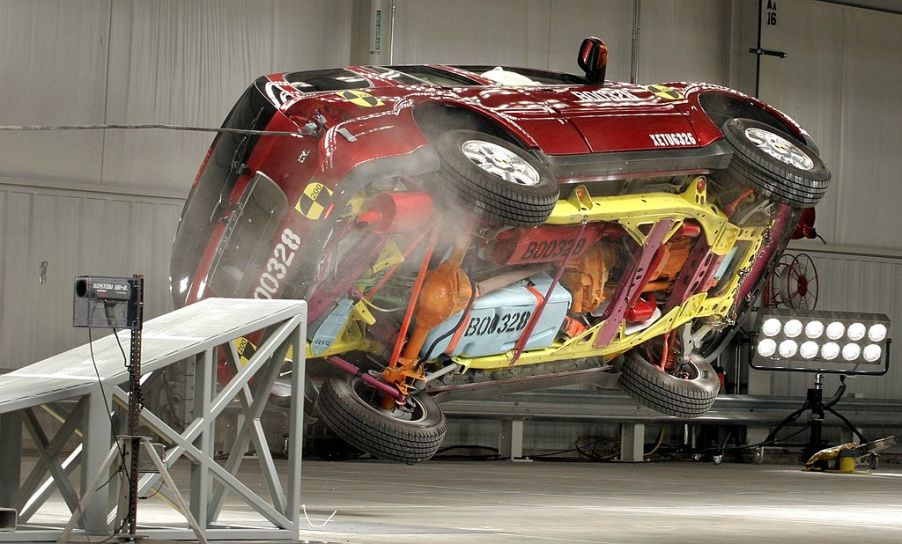
These SUVs Have the Safest Back seats, According to the IIHS
Editor’s Note: This article was updated on 05/23/2023
We do not hear about backseat safety in our cars often. When we see crash test videos, it’s always the driver and front seat passenger getting knocked around. However, as a rule, our most vulnerable passengers will be in the back seats. Our babies and children don’t ride up front. New IIHS data shows that the Ford Escape and the Volvo XC40 were the only SUVs to earn IIHS’s highest rating of “good” so far in back seat crash tests.

Only two SUVs earned the IIHS’s top score in rear seat safety
According to Consumer Reports, the IIHS has just completed its first round of back seat testing using a sample of 15 small SUVs. Of those 15 models used in the crash testing, only the Ford Escape and the Volvo XC40 did well enough to earn the IIHS’s highest rating.
The 2022 Ford Escape didn’t rate all that well overall on CR, but as far as its crash test scores are concerned, it’s an exellent SUV. Reliability concerns, a stiff ride, a flimsy interior, and a noisy 1.5-liter engine left reviewers underwhelmed. That said, as far as rear-seat safety is concerned, the Escape is King. In fact, in the IIHS crash tests, the Ford Escape did exceedingly well across the board.
It’s a similar story with the Volvo XC40, although the Volvo did much better overall than the Ford Escape did. The Volvo has a more powerful powertrain, a much nicer interior, and a smoother ride. Again, that’s not what we are here to talk about. The Volvo XC40 is another safety powerhouse. It also landed top marks across the board on the IIHS’s crash tests.
Both the Ford Escape and the Volvo XC40 earned Top Safety Pick + awards from the IIHS, the group’s highest accolade.
Not all the SUVs tested did so well. The Toyota RAV4 scored second-highest, while the Audi Q3, Nissan Rogue, and Subaru Forester received the second-from-bottom rating. The other nine SUVs used in the test – the Buick Encore, Chevrolet Equinox, Honda CR-V, Honda HR-V, Hyundai Tucson, Jeep Compass, Jeep Renegade, Mazda CX-5, and Mitsubishi Eclipse Cross — received the lowest rating, Poor.
Consumer Reports was right all along

Although this is the first time the IIHS has reported a focused study of rear-seat passengers in a moderate frontal overlap crash test, Consumer Reports has paid attention to rear-seat safety for years.
“In our rear-seat safety features ratings, we reward manufacturers that put proven front-seat safety technologies in the rear seats,” says Emily Thomas, manager of auto safety for CR’s Auto Test Center. “The new ratings from IIHS have the potential to expand the implementation of these technologies, which can improve crash outcomes for rear occupants.”
Why are back seats less safe than the front seats?
This imbalance in protection partly comes from a direct lack of concern for the belting of rear passengers in the back. Front-seat passengers will be endlessly annoyed by seat belt sensors for failing to belt up. However, the back seats of cars rarely have rear seat seat-belt reminders.
Other safety features are also missing from most back seats, like head restraints high enough to matter and advanced seat-belt features that improve both fit and crash performance. Consumer Reports notes that these features have become nearly universal in the front seat, specifically adjustable upper seat-belt anchors, seat-belt pretensioners, and load limiters. These life-saving features have been slow to become standard features in the back seat.
More testing and regulations are certainly coming, given the findings from both Consumer Reports and the IIHS.
“Manufacturers have been slower to include this technology in U.S.-market vehicles, but these new ratings should spur huge safety improvements for rear-seat passengers,” says Thomas. “Over the years, IIHS and Euro NCAP have shown the significant influence consumer crash-testing programs can have on the marketplace.”



